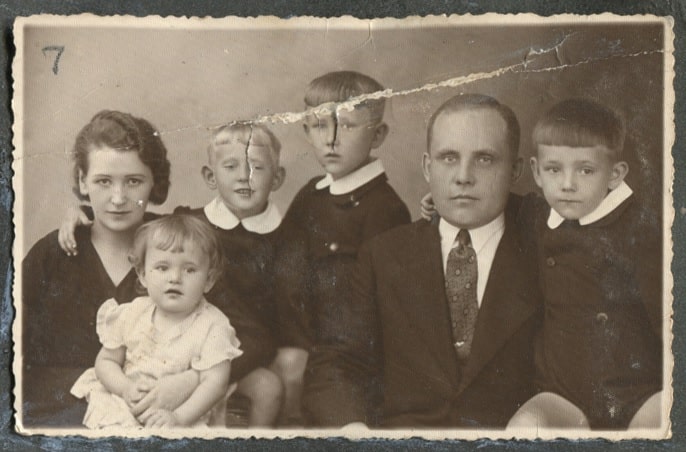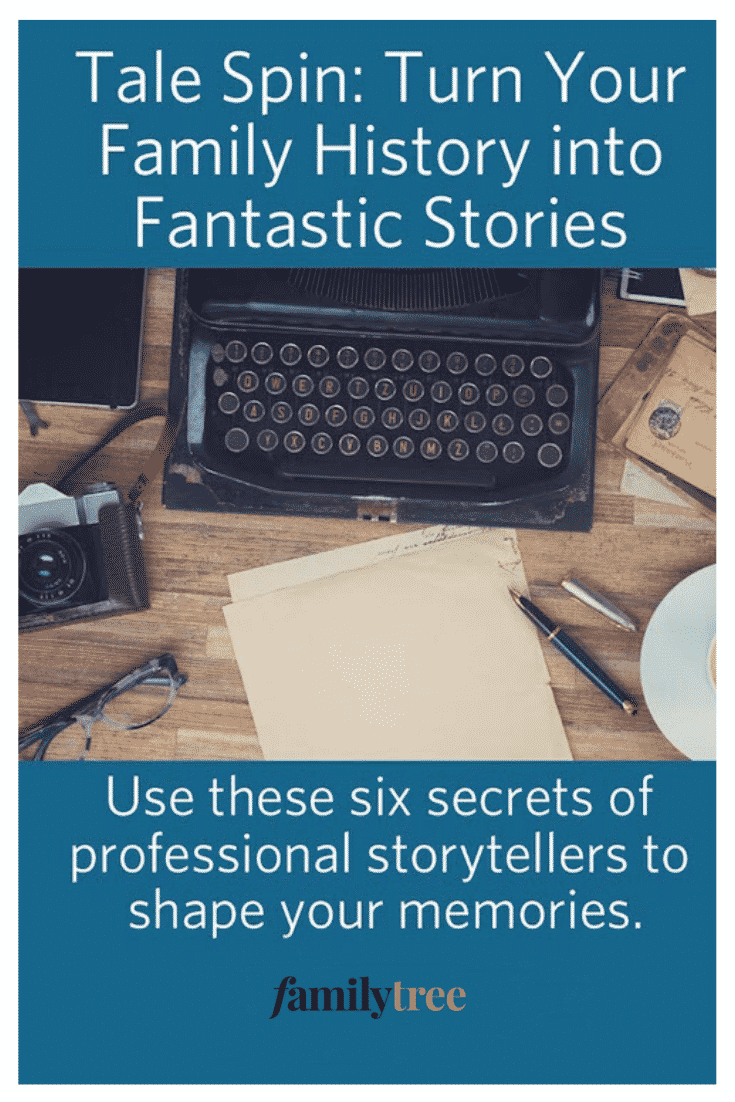Sign up for the Family Tree Newsletter Plus, you’ll receive our 10 Essential Genealogy Research Forms PDF as a special thank you!
Get Your Free Genealogy Forms
"*" indicates required fields

Everyone has stories to tell—more stories than you can count, actually. Our memories overflow with tales of first loves, second chances, lessons learned, triumphs won, prizes lost and faith rekindled. We still chuckle about funny moments. We tear up at thoughts of tender times. We shake our heads at the things we can’t believe we did or said.
But let’s face it: Not all storytellers are created equal. Some folks put their audiences to sleep, while others turn even a trip to the hematologist into a riveting tale.
Your stories deserve to be heard. Use these six secrets of professional storytellers to shape your memories and the details of your family history into tales that will keep people hanging on until the very last word.
1. Understand story anatomy
“What is a story, anyway?” asks Tristine Rainer in Your Life as Story: Writing the New Autobiography (Tarcher). “We all know intuitively. As children we gobble them up and never feel too full for more.”
But telling the stories of our lives isn’t as easy as it might sound. We don’t file away our memories in neat chapters, each with a complete story line. Our most powerful recollections are often sensory images: the smell of Grandpa’s toolshed, the sound of Mother singing.
Other memories are ideas or feelings: fear of the neighbor’s dog, a giddy teen romance. Some are blurred-together composites of repeated events: years of sleep-away camp or holidays with the in-laws. That’s why describing your memories doesn’t automatically make for good storytelling.
“To find a story in your life, you have to know what you’re looking for,” Rainer says. “A story is a meaningful narrative with a beginning, a middle and a conclusion. In its simplest form, a story is what you wanted, how you struggled, and what you realized out of that struggle.”
The task of the storyteller is to flesh out those details. If you recall Grandma’s kitchen or summers at the shore, dig deeper into your memory. Why are these memories strong? What happened there? How did you feel? How did you change? When you start answering questions such as these, you can create life stories that inspire and entertain.
The following excerpt from my grandmother’s memoirs, though short, tells a complete and charming story.
One day in the summertime, my Dad gave me a little pig to raise all by myself. Its mother had died, so he said I could either have the little pig or he would give me money in payment for the many hours I had worked in the field. I fed the little pig by way of a bottle. That little pig became quite a pet and I loved it. One day [it] fell into a slop bucket and drowned.
I cried and cried. Not only my pet was gone but my wages for the summer. I was just heartsick at the loss of my pig. [But] I learned to be careful with slop buckets, and [that] when I make a deal with my dad, it sticks and cannot be changed because of negligence. I think I learned a little about life and disappointments at this early age
Her story isn’t full of adrenaline-fused adventure or rib-tickling comedy. But the beginning, middle and end show you what happened and how she changed. There’s even drama: love, loss and growth.
2. Stick to a single storyline
Our lives aren’t one long tale we can tell from start to finish—most importantly because we haven’t come to the end yet. We should think of our lives as a string of stories, like pearls on a necklace, and tell our stories as we’d string the pearls: one at a time.
Where do you start? With a memory “that has power, a memory that is very strong,” says Bernard Selling in Writing From Within: A Guide to Creativity and Life Story Writing (Hunter House). That memory can come from a critical time, such as the birth or death of a loved one, or your first time away from home. Or it can be a standout moment from everyday life—a fishing trip with your uncle or a day with your best college buddy.
Next, Selling says, “you must develop a sense of where an episode begins and ends, and write only one episode at a time. This is called focus.” A single episode might span an afternoon of a family visit, six weeks of boot camp, or the first year after your father’s death. The length of time isn’t as important as the focus on one storyline.
Once you choose your topic, stick to it. Don’t wander from a friendship with the neighbor to weekends at your aunt’s house unless they share a common theme. My father told me the following story from his years as a traveling business executive:
My dad had always wanted to do what I was doing. I often called him from the road, just to touch base. The first time I had a meeting at the World Trade Center, I called and told him where I was. He made me describe what I saw out the window: the Statue of Liberty and the Brooklyn Bridge. He was even more excited than I was! He taught me that day that you never get tired of your children’s successes.
This single, crisp story doesn’t tell everything about that time in his life, but it shares something important: a universal truth about parental love. Where he chose to start and stop the story affected its meaning. If he had started with a younger memory about his dad’s career, the story might have been more about living up to his father’s legacy or expectations.
3. Use Your Real Voice
For me, the magic of my grandmother’s story about the pig is that when I read it, I can hear her voice. She wrote the story just as she would have spoken it. It includes her favorite turns of phrase; it isn’t too formal or stilted.
Every person’s speech has rhythms and patterns. We tend to repeat certain words or phrases, such as “so” or “wouldn’t you know.” We don’t always use complete sentences. An English teacher might tell you differently, but many writers and historians encourage telling stories as naturally as possible. Your manner of speaking is part of what will make your loved ones love your story—it reflects you.
“Your own language gives the truest story,” says Linda Spence, author of Legacy: A Step-by-Step Guide to Writing Personal History (Swallow Press). “Remember, you’re giving us your story, not necessarily creating a literary classic. Put your internal critic on hold and keep writing.”
Using your own voice also means speaking simply and forthrightly. In Writing from Within, Selling encourages you to tell stories with childlike directness. “Simple, direct, emotional, visual language that creates pictures and feelings will aid us in finding the hidden moments from our past.”
One way that you can find your natural storytelling voice is to record yourself telling the story, then transcribe it later. You also can try a trick that’s worked for me: Dash off a quick e-mail version of the story to a friend. E-mail language is usually casual, so the result will be closer to your natural voice.
If you’d rather write your story, read your work aloud after you’ve finished. See if it sounds like your natural speaking voice. If it doesn’t, rewrite it until it does. Look at every sentence and ask yourself, “Is this really how I’d say this? How can I say this with fewer words?” Fewer words usually result in more direct language.
The most important part of using your real voice is telling the truth. If you fudge the plot to make yourself look better or someone else look worse, you run real risks. First, you could sound false and your audience won’t trust you. You also risk hurting people you love, and you could lose an opportunity to teach lessons you’ve learned.
“Look back with tenderness and courage and write from your heart,” Spence writes. “Perhaps someone, someday, will find what he or she needs to live life with more understanding, compassion, confidence and acceptance.”
4. Start in the right place
Every story has a timeline, but that doesn’t mean we have to tell events in order. Professional writers often end up cutting or moving the first sentences, paragraphs or even chapters of their stories. They find that the background, or “backstory,” doesn’t have to come first to get readers interested. In fact, too much background can be boring.
In her memoir Five-Finger Discount: A Crooked Family History (Random House), Helene Stapinski talks about her grandfather’s troubled youth, her parents’ marriage, and her own early memories of her grandparents. She starts with this incredible sentence:
“The night my grandfather tried to kill us, I was five years old, the age I stopped believing in Santa Claus, started kindergarten and made real rather than imaginary friends.”
A good way to find your story’s most riveting moment is to think of the scene you would use in a movie trailer for your life. You don’t want to give everything away in your opening—just as an ad for a movie wouldn’t—but you need to hook your audience.
Don’t sweat it if you don’t have a murder-and-mayhem opening. In most stories, the drama is subtle. Consider starting with a moment of irony or surprise:
I never expected one song to change my life, but within 10 months of slow dancing with Jeremy Morton, I married him.
Try telling the story to a captive (and forgiving) audience. When your listeners lean forward in their seats and start really paying attention, take note—their reaction means they’re riveted. Try starting your tale at that point.
5. Include all the juicy details
I had a college writing teacher whose passion for detail bordered on reverence. “It’s those divine details that will bring your pieces alive!” she’d declare. “What was playing on the jukebox at the restaurant? Was his brown wool jacket scratchy against your cold cheek?”
“Details may seem uninteresting or insignificant to you, but they’re important,” Spence advises in Legacy. “Pay attention to them. Your reader will find them more meaningful than general descriptions.”
Include the details you remember most vividly. A friend of mine who’s a professional musician best recalls sounds—a melody, the lilt of her aunt’s voice, the patter of rain on the porch roof. My husband, a mechanic, seems to have a 3-D memory. He talks about the layout of his childhood homes, and where he played with which toys.
But don’t go overboard—be selective with the details you include. “[Use] well chosen-details to convey information and feeling,” Selling advises in Writing From Within. “The most interesting and useful details seem to be those that give a glimpse into the character” or event you’re describing.
Say you’re describing the years following your parents’ divorce. You recall peeking through the curtains as your mother’s new boyfriend drove up. Would you emphasize the dusty white lace curtains or how the man straightened his thinning hair in the rear-view mirror of his dented-up Datsun? Your story isn’t about housekeeping: Describe the boyfriend.
Details are also key to conveying your composite memories from often-repeated events. For example, my memories of childhood Christmases blur together. The best way I can bring these to life is with a single, detailed anecdote:
One year during the family Christmas program, my brothers and I acted out the Nativity. We didn’t have enough actors, so Chris played both a shepherd and the angel who talked to him. John piled blankets across his shoulders and called himself all three wise men. Rich represented both the donkey Mary rode to Bethlehem and the stable animals. As the only girl, I was just Mary. I sat on Rich’s back and tried not to laugh. Nights like these instilled in me respect for—and a sense of humor about—religious things.
Having a hard time remembering details? “Concentrating on one stage of your life at a time will stir up rich details and feelings,” Spence suggests. “Look deeply into photographs or handle an object connected to the time or person you are trying to describe. Read old letters, look through a yearbook or listen to music connected to a certain time.”
Though being specific is important, don’t get bogged down by minor details. You’ve probably heard a storyteller falter: “Wait, no, it wasn’t 1946, it was 1945 … oh, maybe not … ” When that happens, a story loses its momentum. If you don’t remember exactly when you moved to Illinois and it’s not vital to the story, don’t fuss about it.
6. Make your point
This last secret to successful storytelling is the most significant: Your story has to mean something. “You would be surprised how many people forget that a story is supposed to [embody] a human truth,” Rainer says in Your Life as Story. “What drives me crazy is stories that go on and on and never have a satisfying conclusion. Unless it makes a point, you don’t have a story.”
Your point doesn’t have to be a sweeping moral truth, but you need to have a reason for telling the story. What did you learn? How did you grow or change, physically or mentally? How did you come to see the world differently? You can state your point directly, as in some of the anecdotes I’ve shared. My grandmother says she learned “when I make a deal with my dad, it sticks and cannot be changed because of negligence.” The best stories show how the person feels throughout, so that by the end, you don’t have to spell out the main character’s change of heart or perspective.
As Selling writes, “It’s not enough to mention a feeling at the beginning of the story and another at the end. Our feelings and those of the [other] characters have to be added to each moment of the story.” Consider the feelings conveyed in my grandmother’s story: She loved the pig; she cried when it died. She was heartsick at the thought of losing her summer’s wages. She learned about disappointment. Some would-be storytellers don’t like to get all flowery about their feelings, and that’s OK. The more simply you state your emotions, the better. If you felt sad, betrayed, or shocked, just say so: “I was shocked.” Just make sure your listeners know why from the surrounding narrative.
Once you complete one story, you’ll soon think of others to tell. Though each tale will likely have a different format or topic, several episodes strung together will begin to create your life story. As we tell our stories, we often find new meaning in our lives’ events. We are richer for it, as are those who listen, in the present or in the future. So search your memories, clear your throat, and start stringing those pearls.
Last updated: November 2019
Pin this article for later!

ADVERTISEMENT




